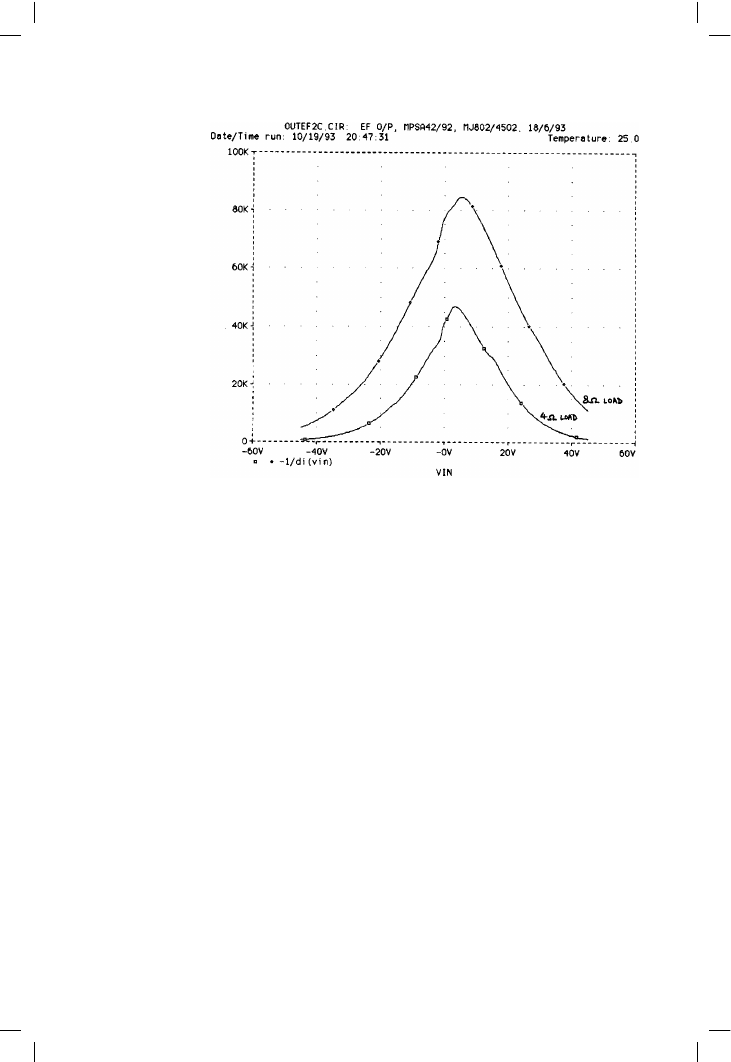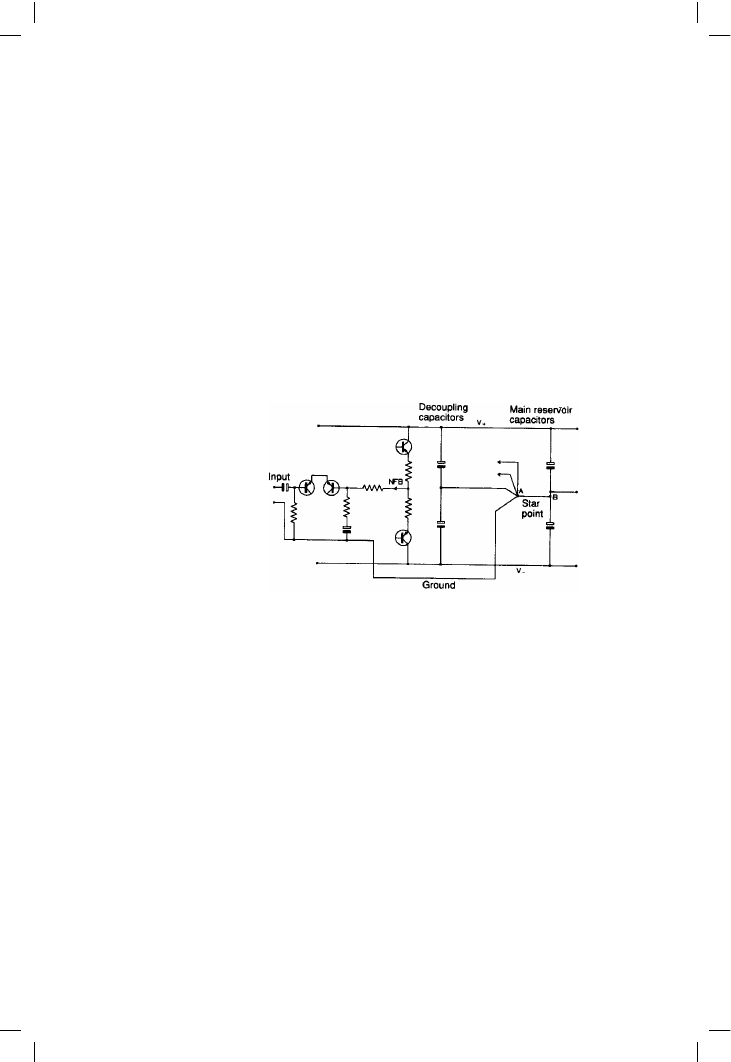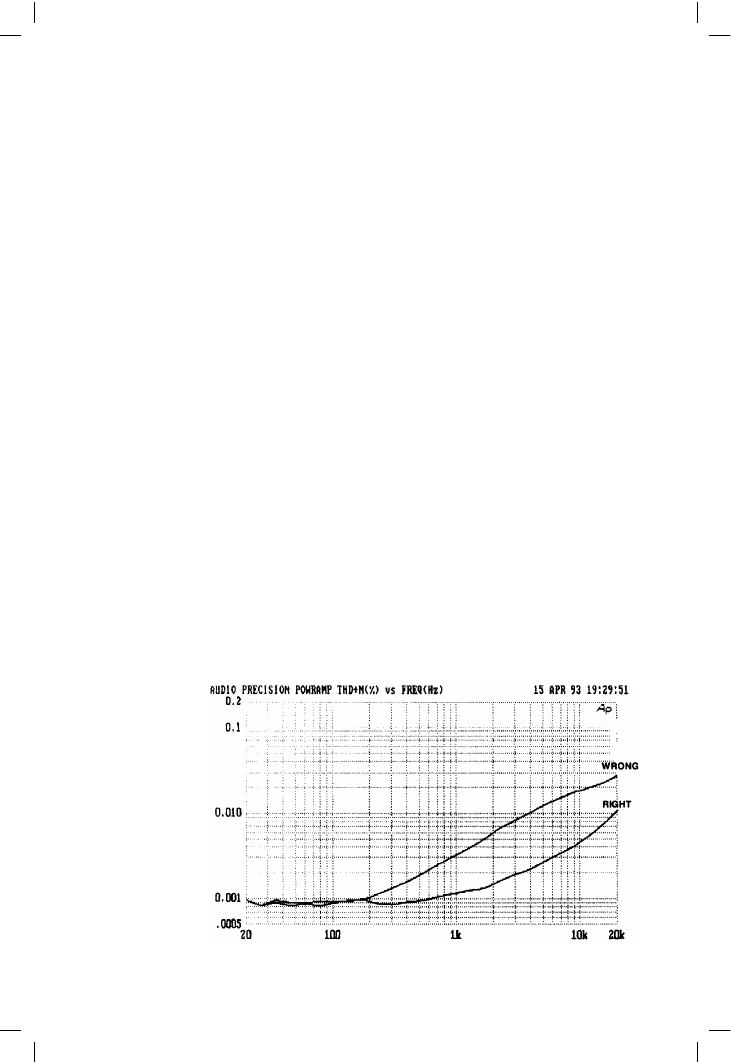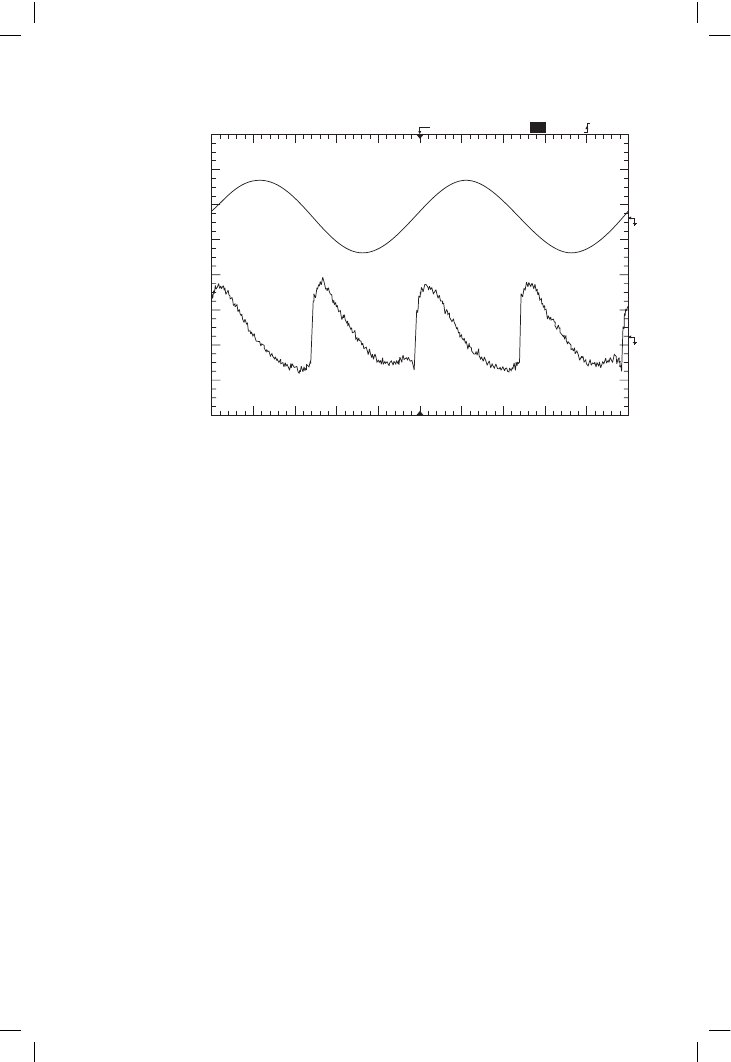ВУЗ: Казахская Национальная Академия Искусств им. Т. Жургенова
Категория: Учебное пособие
Дисциплина: Не указана
Добавлен: 03.02.2019
Просмотров: 17415
Скачиваний: 18

The output stage II
buffering is not required, so this method has a lower component count. The
only drawback is a greater tendency to parasitic oscillation near negative
clipping, when used with a CFP output stage.
Figure 6.3 confirms that the input impedance of a conventional EF Type I
output stage is highly non-linear; the data is derived from a SPICE output
stage simulation with optimal Iq. Even with an undemanding 8 ! load, the
impedance varies by 10:1 over the output voltage swing. The Type II EF
output (using a shared drive emitter resistance) has a 50% higher
impedance around crossover, but the variation ratio is rather greater. CFP
output stages have a more complex variation that includes a precipitous
drop to less than 20 k! around the crossover point. With all types under-
biasing produces additional sharp impedance changes at crossover.
Distortion number 5: rail decoupling distortion
Almost all amplifiers have some form of rail decoupling apart from the
main reservoir capacitors; this is usually required to guarantee HF stability.
Standard decoupling arrangements include small to medium-size electro-
lytics (say 10–470 µF) connected between each rail and ground, and an
inevitable consequence is that rail-voltage variations cause current to flow
into the ground connection chosen. This is just one mechanism that defines
the Power Supply Rejection Ratio (PSRR) of an amplifier, but it is one that
can seriously damage linearity.
165
Figure 6.3
Distortion 4 and its
root cause; the non-
linear input impedance
of an EF Class-B output
stage

Audio Power Amplifier Design Handbook
If we use an unregulated power supply (and there are almost overwhelming
reasons for using such a supply, detailed in Chapter 8) comprising
transformer, bridge rectifier, and reservoir capacitors, then these rails have
a non-zero AC impedance and their voltage variations will be due to
amplifier load currents as well as 100 Hz ripple. In Class-B, the supply-rail
currents are halfwave-rectified sine pulses with strong harmonic content,
and if they contaminate the signal then distortion is badly degraded; a
common route for interaction is via decoupling grounds shared with input
or feedback networks, and a separate decoupler ground is usually a
complete cure. This point is easy to overlook, and attempts to improve
amplifier linearity by labouring on the input pair, VAS, etc. are doomed to
failure unless this distortion mechanism is eliminated first. As a rule it is
simply necessary to take the decoupling ground separately back to the
ground star point, as shown in Figure 6.4. (Note that the star-point A is
defined on a short spur from the heavy connection joining the reservoirs;
trying to use B as the star point will introduce ripple due to the large
reservoir-charging current pulses passing through it.)
Figure 6.5 shows the effect on an otherwise Blameless amplifier handling
60 W/8 !, with 220 µF rail decoupling capacitors; at 1 kHz distortion has
increased by more than ten times, which is quite bad enough. However, at
20 Hz the THD has increased at least 100-fold, turning a very good
amplifier into a profoundly mediocre one with one misconceived
connection.
When the waveform on the supply rails is examined, the 100 Hz ripple
amplitude will usually be found to exceed the pulses due to Class-B signal
current, and so some of the distortion on the upper curve of the plot is
actually due to ripple injection. This is hinted at by the phase-crevasse at
100 Hz, where the ripple happened to partly cancel the signal at the instant
of measurement. Below 100 Hz the curve rises as greater demands are
made on the reservoirs, the signal voltage on the rails increases, and more
distorted current is forced into the ground system.
166
Figure 6.4
Distortion 5; The
correct way to route
decouple grounding to
the star-point

1
2
10.0V
200
2.00
0.00s
1 STOP
/
m
v
m
v
1
2
The output stage II
Figure 6.6 shows a typical Distortion 5 residual, produced by deliberately
connecting the negative supply-rail decoupling capacitor to the input
ground instead of properly giving it its own return to the far side of the star-
point. THD increased from 0.00097% to 0.008%, appearing mostly as
second harmonic. Distortion 5 is usually easy to identify as it is
accompanied by 100 Hz power-supply ripple; Distortions 6 and 7
introduce no extra ripple. The ripple contamination here – the the two
humps at the bottom – is significant and contributes to the THD reading.
As a general rule, if an amplifier is made free from ripple injection under
drive conditions, demonstrated by a THD residual without ripple
167
Figure 6.5
Distortion 5 in action;
The upper trace was
produced simply by
taking the decoupler
ground from the star-
point and connecting it
via the input ground
line instead
Figure 6.6
Distortion 5 revealed.
Connecting the rail
decoupler to input
ground increases
THD eight-fold from
0.00097% to
0.008%, mostly as
second harmonic.
100 Hz ripple is also
visible. No
averaging

Audio Power Amplifier Design Handbook
components, there will be no distortion from the power-supply rails, and
the complications and inefficiencies of high-current rail regulators are
quite unnecessary.
There has been much discussion of PSRR-induced distortion in the
literature recently, e.g. Greg Ball
[1]
. I part company with some writers at the
point where they assume a power amplifier is likely to have 25 dB PSRR,
making an expensive set of HT regulators the only answer. Greg Ball also
initially assumes that a power amp has the same PSRR characteristics as an
op-amp, i.e. falling steadily at 6 dB/octave. There is absolutely no need for
this to be so, given a little RC decoupling, and Ball states at the end of his
article that a more elegant solution . . . is to depend on a high PSRR in the
amplifier proper. This issue is dealt with in detail in Chapter 8.
Distortion number 6: induction distortion
The existence of this distortion mechanism, like Distortion 5, stems directly
from the Class-B nature of the output stage. With a sine input, the output
hopefully carries a good sinewave, but the supply-rail currents are
halfwave-rectified sine pulses, which will readily crosstalk into sensitive
parts of the circuit by induction. This is very damaging to the distortion
performance, as Figure 6.7 shows.
The distortion signal may intrude into the input circuitry, the feedback path,
or even the cables to the output terminals. The result is a kind of sawtooth
on the distortion residual that is very distinctive, and a large extra distortion
component that rises at 6 dB/octave with frequency.
A Distortion 6 residual is displayed in Figure 6.8. The V-supply rail was
routed parallel to the negative-feedback line to produce this diagram. THD
is more than doubled, but is still relatively low at 0.0021%. 64-times
168
Figure 6.7
Distortion 6 exposed.
The upper trace shows
the effects of Class-B
rail induction into
signal circuitry

1
2
20.0V
20.0
0.00s
200
1 RUN
/
m
v
!
s
AV
1
2
The output stage II
averaging is used. Distortion 6 is easily identified if the DC supply cables
are movable, for altering their run will strongly affect the quantity
generated.
This inductive effect appears to have been first publicised by Cherry
[2]
, in
a paper that deserves more attention. The effect has however been
recognised and avoided by some practitioners for many years
[3]
. However,
having examined many power amplifiers with varying degrees of virtue, I
feel that this effect, being apparently unknown to most designers, is
probably the most widespread cause of unnecessary distortion.
The contribution of Distortion 6 can be reduced below the measurement
threshold by taking sufficient care over the layout of supply-rail cabling
relative to signal leads, and avoiding loops that will induce or pick up
magnetic fields. I wish I could give precise rules for layout that would
guarantee freedom from the problem, but each amplifier has its own
physical layout, and the cabling topology has to take this into account.
However, here are some guidelines:
Firstly, implement rigorous minimisation of loop area in the input and
feedback circuitry; keeping each signal line as close to its ground return as
possible. Secondly, minimise the ability of the supply wiring to establish
magnetic fields in the first place; thirdly, put as much distance between
these two areas as you can. Fresh air beats shielding on price every
time.
Figure 6.9 shows one straightforward approach to solving the problem; the
supply and ground wires are tightly twisted together to reduce radiation. In
practice this doesn’t seem too effective, for reasons that are not wholly
169
Figure 6.8
Distortion 6.
Induction of half-
wave signal from the
negative supply rail
into the NFB line
increases THD to
0.0021%. Averaged
64 times